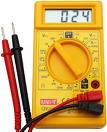Phantom Loads: A Possible Battery Draining Source
Phantom Loads may be draining a small portion of current from your house batteries.
You Will Need A Multimeter

When you are going about your business of recreating in your Class C Motorhome, you will be using lights, TVs, computers, smoke detectors... all types of stuff. It is easy to assume that they will stop using power when we turn these electrical and electronic devices off.
When you turn off a piece of equipment and it appears to be just sitting there doing nothing, it may still be draining a small portion of current from your house batteries. This is a type of phantom load. Most of these energy vampires are in the milliamp range (a thousandth of an amp), but these loads can, over time, drain your battery flat.
These types of phantom loads can pop up in all kinds of areas, and the only way you can find the little buggers is with a good, but not necessarily expensive, multimeter.

These meters range in price from under $5 to over $100. However, a $5 multimeter will work just fine for this type of testing.
You will need to make sure that all of your appliances and electronic equipment have been turned off, and if necessary, unplugged.
A word of caution is needed here. Any battery the size and configuration of a Deep Cycle Battery is very dangerous. These batteries contain a sulfuric acid electrolyte, which is a corrosive liquid. This acid can emit flammable hydrogen gas… think Hindenburg. Always be sure you and your batteries are in a well-ventilated space.
You do not want to smoke around these things and avoid making any sparks or open flames. If you do get acid on you, dilute it down immediately with lots and lots of cold water. You should ALWAYS wear safety glasses and protective clothing around these batteries.
When testing any 12 V DC battery for a phantom load, always disconnect the negative (black) battery terminal first because doing so greatly reduces the chance of inadvertent sparking.
 This would also be a good time to take the opportunity to clean your terminals with a wire brush using water and baking soda. However, do not under any circumstances allow the baking soda mixture to contaminate any of the battery cells… how can you spell dead battery?
This would also be a good time to take the opportunity to clean your terminals with a wire brush using water and baking soda. However, do not under any circumstances allow the baking soda mixture to contaminate any of the battery cells… how can you spell dead battery?
Next, set the multimeter selector switch to the amp position and touch the negative battery (black) cable with your negative (black) meter lead. You then want to use your positive (red) terminal lead on the multimeter and touch the Positive (red) terminal of your battery. Look for a phantom voltage in the milliamp range.
Once you identify a phantom load, you can then isolate the circuit and eliminate the problem. You do this by going to your fuse panel located inside the RV and pulling all of the fuses and/or opening all the circuit breakers. Reinsert your fuses and/or close your circuit breakers one at a time while continuing your test.
Once you have located the circuit, then it is just a matter of isolating the problem. Usually it turns out to be stereo receivers, electronically controlled refrigerators, and smoke, CO2, and propane detectors that are all tiny drains on the batteries and causing the problem. After your circuit testing is completed, ensure that all of your circuit breakers are closed and the fuses have been re-installed.
You will never, or very seldom, find a problem in the middle of a cable run unless you inadvertently put a screw through one while you were installing awning brackets or something similar. It is really not a good idea to start poking holes in your Class C Motorhome. As an example, if you are installing solar cell panels, attempt to use an existing penetration hole like your existing vent for the refrigerator.
I felt that my deep cycle battery was draining much too fast. I had nothing to compare it to... I had no reference point. I did not know what was “normal”. I did not know that phantom loads even existed. All I knew was that when I was off the grid, my battery would seem to drain even when I had everything shut down.
I was using a twelve-volt group 24 battery that gave me around 80 amp/hours of service. I figured that well, maybe my battery was just too small. So I replaced it with a group 31, 125 amp/hour battery. It helped a little bit, but it still didn’t seem right.
I started asking questions, and I just happened to be in an RV supply & parts store talking to the counter person about this problem. A Dometic Service representative, who just happened to be in the store, overheard my conversation.
He said to look for a Climate Control Switch on my Dometic refrigerator. This switch was there... it controls a heating element just inside of the door. It is to be used in a high humidity climate and helps keep condensation down in the fridge. However, if left on while on battery power, it would drain batteries very fast.
I checked it out and sure enough, the sucker was on. This switch is located on the front of the unit between the freezer door and the refrigerator door.
This helped immensely to reduce the phantom voltage drain, but things still did not seem quite right. It wasn’t until I did a full isolation check with my multimeter that I chased down the last of my phantom loads.
This last phantom load was 300 milliamps (mA)... Milli = 1000, so this is a little under 1/3 of an ampere draw.
I knew that I had all my electronics turned off and unplugged, so I simply started pulling fuses to see if I could isolate this problem. I got lucky... the first one that I pulled was a 20 amp fuse for my Winegard TV Antenna.
Winegard uses a control switch allowing a choice between the TV antenna input and a cable input. When I switched to cable input my phantom load went away. It appears that there is some type of signal amplifier involved with the TV antenna.
Although it was a small amp draw of only 300 milliamps... that converts to one third of an amp every hour. In a 24 hour time frame, that would add up to over 6 amperes wasted for no good reason. That works out to 30 amperes in five days!
If you are using an inverter (a device that converts 12 DC to 120 V AC) and you leave your TV plugged in and turned off, it may still be drawing power! A 50-Watt TV could draw as many as 10 to 15 Watts when it is turned off. You should unplug it or install an on/off switch in the power cord.
An inverter plugged in creates a phantom load even if it is not converting power. That's one of the things to look for when setting up your system. A good newer unit will have a highly efficient conversion ratio. This means a cleaner sine wave and not a lot of wasted power.
Bottom line, if you have never checked for these energy vampires, you may be shooting yourself in the foot. It is natural to adapt to the conditions around us. We all do it.
We may very well have a Class C Motorhome leaking electricity and not even know it... we may have batteries draining faster than they should, and not know it!
Before Honda and Toyota set the standards for automobile manufacturing, we all used to drive around in cars with "personality". We actually convinced ourselves that a car with faults had personality!
Our motorhomes can be the same way. We get used to what we have. If you check your Class C Motorhome for phantom loads, then you will know. You may not have any... but you may well have some.

Return To Top Of Page
Leave Phantom Loads May Be Draining A Small Portion Of Current page, And Return ToRV Tips: Some Thoughts On Bringing Out The Best In Your Class C Motorhome Page
Leave Phantom Loads May Be Draining A Small Portion Of Current page And Return To Class C Motorhome Info.
Made Simple Homepage
YOUR STORIES
1995 Tioga Montara
Had a Leak - Ouch!
A Simple Way To Put An Electrical Thermostat On A Small Space Heater
In A Truck Camper!
A Great Destinaton, With An Unexpected Outcome!
Test Link
Below: For An Alternative Destination... A Four Mile Hike Around Sugar Pine Reservoir

A Good Place To Begin The Joshua M. Hardt Memorial Trail Is At The Dam. This 3.5 Mile Trail Is Good For Foot Traffic And Bicycles... No Motorized stuff

The Manzanita Day Use Area Is A Good Place To Sit And Watch The Wind
Play With The Water!

Another View From The Joshua M. Hardt Memorial Trail... Morning and Evening Are The Best Times To Hike This Trail. The Still Reflections Will Capture Your Attention

You May Want To Bring A Camera... There Are Large Birds Of Prey High In The Ski





